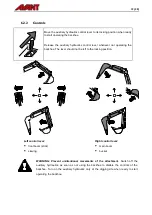
7 (28)
Pay attention to the surroundings and any other persons and machines moving in the
vicinity. Pay attention to the contours of the terrain and other hazards, such as
branches and trees that can reach to the driver's area, loose rocks, and slippery
surfaces.
Never leave the driver’s seat when the bucket is lifted off from the ground. Keep
hands and feet away from moving parts.
Make sure not to tilt the digger too far up causing material to fall from the bucket on
the loader or operator’s area.
When removing the digger from the loader, ensure that it is secured against
accidental movement. Familiarise yourself with the instructions concerning taking the
digger off from the loader and storage.
Make sure that overhead clearance is sufficient. Hitting an overhead obstacle may
cause the loader to tip over. Keep a safe distance from electric cables, lamps, or
other electric systems; hitting live parts may cause electric shock.
Ensure that ventilation is sufficient when operating indoors. Do not operate the loader
in closed spaces regardless of the engine or fuel type. Exhaust gases may
concentrate to hazardous levels.
Operate the controls of the loader in a slow and calm manner. Be careful when lifting
load to high level or lifting load from high. Avoid sudden changes in speed or
direction to maintain balance of the loader especially when handling heavy loads.
Drive slowly and carefully especially on inclined terrain or slippery surfaces.
Carrying heavy loads can shift the centre of gravity of the loader and lead to tipping
over of the loader. Always transport the load as low and close to the machine as
possible with the telescopic boom completely retracted to keep the centre of gravity
low and for the best stability.
The stability of the loader may change when leaving the driver’s seat, leading to
tipping over of the machine. Always remember that the boom may lower
unexpectedly due to loss of stability, mechanical fault, or if another person operates
the controls of the loader, leading to crushing hazard. The attachment or the loader
are not intended to be left to keep a load elevated for longer periods. Lower the
attachment before leaving the driver's seat.
Keep the loader articulation in straight position when handling heavy loads. When
turning the articulation, the loader may tilt forward.
Observe maximum load i
ndicated in the operator’s manual of the loader. Be
especially careful when the load sensor indicator is activated.
Make sure that the surface can bear the total load. Also follow the correct tyre
pressure settings.
Make sure to use only an attachment that is in good condition. Check the attachment
thoroughly in regular intervals. Do not modify the attachment in a manner that would
affect its safety. It is prohibited to drill holes on the attachment, and welding or other
means of fixing hooks or other objects on the attachment is strictly prohibited.
Use the attachment only for its intended purpose. Other use may create unnecessary
safety risks, and the equipment may get damaged.
Make sure that the loader is equipped with necessary safety components, and that
they are in working condition. Seat belt must be used. If there are specific hazards
related to the operating area, use appropriate safety equipment.
Also read the safety instructions and correct use of the loader from the operator's
manual of the loader.

























